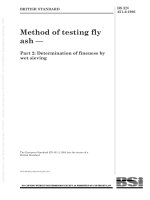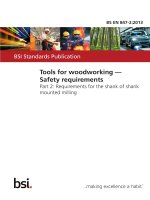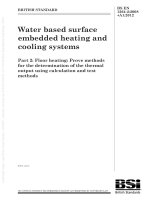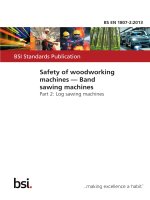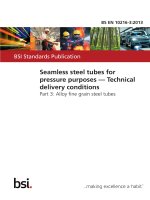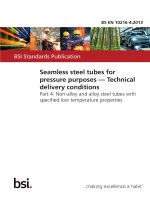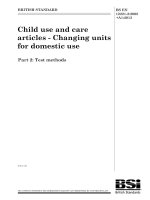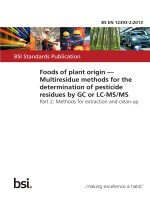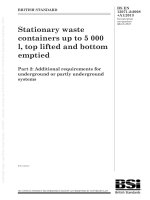Bsi bs en 10216 2 2013
Bạn đang xem bản rút gọn của tài liệu. Xem và tải ngay bản đầy đủ của tài liệu tại đây (1.34 MB, 50 trang )
BS EN 10216-2:2013
BSI Standards Publication
Seamless steel tubes for
pressure purposes — Technical
delivery conditions
Part 2: Non-alloy and alloy steel tubes with
specified elevated temperature properties
BS EN 10216-2:2013
BRITISH STANDARD
National foreword
This British Standard is the UK implementation of EN 10216-2:2013.
It supersedes BS EN 10216-2:2002 +A2:2007 which is withdrawn.
The UK participation in its preparation was entrusted to Technical
Committee ISE/110, Steel Tubes, and Iron and Steel Fittings.
A list of organizations represented on this committee can be
obtained on request to its secretary.
This publication does not purport to include all the necessary
provisions of a contract. Users are responsible for its correct
application.
© The British Standards Institution 2013. Published by BSI Standards
Limited 2013
ISBN 978 0 580 68641 2
ICS 23.040.10; 77.140.75
Compliance with a British Standard cannot confer immunity from
legal obligations.
This British Standard was published under the authority of the
Standards Policy and Strategy Committee on 31 December 2013.
Amendments issued since publication
Date
Text affected
BS EN 10216-2:2013
EN 10216-2
EUROPEAN STANDARD
NORME EUROPÉENNE
EUROPÄISCHE NORM
December 2013
ICS 23.040.10; 77.140.75
Supersedes EN 10216-2:2002+A2:2007
English Version
Seamless steel tubes for pressure purposes - Technical delivery
conditions - Part 2: Non-alloy and alloy steel tubes with specified
elevated temperature properties
Tubes sans soudure en acier pour service sous pression Conditions techniques de livraison - Partie 2: Tubes en
acier non allié et allié avec caractéristiques spécifiées à
température élevée
Nahtlose Stahlrohre für Druckbeanspruchungen Technische Lieferbedingungen - Teil 2: Rohre aus
unlegierten und legierten Stählen mit festgelegten
Eigenschaften bei erhöhten Temperaturen
This European Standard was approved by CEN on 17 August 2013.
CEN members are bound to comply with the CEN/CENELEC Internal Regulations which stipulate the conditions for giving this European
Standard the status of a national standard without any alteration. Up-to-date lists and bibliographical references concerning such national
standards may be obtained on application to the CEN-CENELEC Management Centre or to any CEN member.
This European Standard exists in three official versions (English, French, German). A version in any other language made by translation
under the responsibility of a CEN member into its own language and notified to the CEN-CENELEC Management Centre has the same
status as the official versions.
CEN members are the national standards bodies of Austria, Belgium, Bulgaria, Croatia, Cyprus, Czech Republic, Denmark, Estonia,
Finland, Former Yugoslav Republic of Macedonia, France, Germany, Greece, Hungary, Iceland, Ireland, Italy, Latvia, Lithuania,
Luxembourg, Malta, Netherlands, Norway, Poland, Portugal, Romania, Slovakia, Slovenia, Spain, Sweden, Switzerland, Turkey and United
Kingdom.
EUROPEAN COMMITTEE FOR STANDARDIZATION
COMITÉ EUROPÉEN DE NORMALISATION
EUROPÄISCHES KOMITEE FÜR NORMUNG
CEN-CENELEC Management Centre: Avenue Marnix 17, B-1000 Brussels
© 2013 CEN
All rights of exploitation in any form and by any means reserved
worldwide for CEN national Members.
Ref. No. EN 10216-2:2013 E
BS EN 10216-2:2013
EN 10216-2:2013 (E)
Contents
Page
Foreword ...................................................................................................................................................................... 4
Introduction ................................................................................................................................................................. 5
1
Scope .............................................................................................................................................................. 6
2
Normative references .................................................................................................................................... 6
3
Terms and definitions ................................................................................................................................... 7
4
Symbols .......................................................................................................................................................... 7
5
5.1
5.2
Classification and designation ..................................................................................................................... 8
Classification.................................................................................................................................................. 8
Designation .................................................................................................................................................... 8
6
6.1
6.2
6.3
Information to be supplied by the purchaser ............................................................................................. 8
Mandatory information .................................................................................................................................. 8
Options ........................................................................................................................................................... 9
Examples of an order .................................................................................................................................... 9
7
7.1
7.2
Manufacturing process ............................................................................................................................... 10
Steel making process .................................................................................................................................. 10
Tube manufacture and delivery conditions .............................................................................................. 10
8
8.1
8.2
8.3
8.4
8.5
8.6
8.7
Requirements ............................................................................................................................................... 11
General .......................................................................................................................................................... 11
Chemical composition ................................................................................................................................ 12
Mechanical properties ................................................................................................................................. 16
Appearance and internal soundness ......................................................................................................... 21
Straightness ................................................................................................................................................. 21
Preparation of ends ..................................................................................................................................... 21
Dimensions, masses and tolerances ......................................................................................................... 22
9
9.1
9.2
9.3
Inspection ..................................................................................................................................................... 27
Types of inspection ..................................................................................................................................... 27
Inspection documents ................................................................................................................................. 27
Summary of inspection and verification testing ...................................................................................... 28
10
10.1
10.2
Sampling ....................................................................................................................................................... 29
Frequency of tests ....................................................................................................................................... 29
Preparation of samples and test pieces .................................................................................................... 29
11
11.1
11.2
11.3
11.4
11.5
11.6
11.7
11.8
11.9
11.10
11.11
11.12
11.13
Verification test methods ............................................................................................................................ 30
Chemical analysis ........................................................................................................................................ 30
Tensile test ................................................................................................................................................... 31
Flattening test .............................................................................................................................................. 31
Ring tensile test ........................................................................................................................................... 32
Drift expanding test ..................................................................................................................................... 32
Ring expanding test..................................................................................................................................... 33
Impact test .................................................................................................................................................... 34
Leak tightness test ...................................................................................................................................... 34
Dimensional inspection .............................................................................................................................. 35
Visual examination ...................................................................................................................................... 35
Non-destructive testing ............................................................................................................................... 35
Material identification .................................................................................................................................. 35
Retests, sorting and reprocessing ............................................................................................................. 36
12
12.1
12.2
Marking ......................................................................................................................................................... 36
Marking to be applied .................................................................................................................................. 36
Additional marking ...................................................................................................................................... 36
13
Protection ..................................................................................................................................................... 36
2
BS EN 10216-2:2013
EN 10216-2:2013 (E)
Annex A (informative) Creep rupture strength values .................................................................................. 37
Annex B (informative) Technical changes from the previous edition ......................................................... 43
B.1
Introduction .......................................................................................................................................... 43
B.2
Technical changes .............................................................................................................................. 43
Annex ZA (informative) Relationship between this European Standard and the Essential
Requirements of EU Directive 97/23/EC ............................................................................................ 44
Bibliography ...................................................................................................................................................... 45
3
BS EN 10216-2:2013
EN 10216-2:2013 (E)
Foreword
This document (EN 10216-2:2013) has been prepared by Technical Committee ECISS/TC 110 “Steel tubes
and fittings for steel tubes”, the secretariat of which is held by UNI.
This European Standard shall be given the status of a national standard, either by publication of an identical
text or by endorsement, at the latest by June 2014, and conflicting national standards shall be withdrawn at
the latest by June 2014.
Attention is drawn to the possibility that some of the elements of this document may be the subject of patent
rights. CEN [and/or CENELEC] shall not be held responsible for identifying any or all such patent rights.
This document supersedes EN 10216-2:2002+A2:2007.
For the list of the most significant technical changes that have been made in this new edition, see Annex B.
This document has been prepared under a mandate given to CEN by the European Commission and the
European Free Trade Association, and supports essential requirements of EU Directive(s).
For relationship with EU Directive(s), see informative Annex ZA, which is an integral part of this document.
This European Standard consists of the following parts, under the general title "Seamless steel tubes for
pressure purposes – Technical delivery conditions":
Part 1: Non-alloy steel tubes with specified room temperature properties
Part 2: Non-alloy and alloy steel tubes with specified elevated temperature properties (the present
document)
Part 3: Alloy fine grain steel tubes
Part 4: Non-alloy and alloy steel tubes with specified low temperature properties
Part 5: Stainless steel tubes
Another European Standard series covering tubes for pressure purposes is:
EN 10217, Welded steel tubes for pressure purposes – Technical delivery conditions
According to the CEN-CENELEC Internal Regulations, the national standards organizations of the following
countries are bound to implement this European Standard: Austria, Belgium, Bulgaria, Croatia, Cyprus, Czech
Republic, Denmark, Estonia, Finland, Former Yugoslav Republic of Macedonia, France, Germany, Greece,
Hungary, Iceland, Ireland, Italy, Latvia, Lithuania, Luxembourg, Malta, Netherlands, Norway, Poland, Portugal,
Romania, Slovakia, Slovenia, Spain, Sweden, Switzerland, Turkey and the United Kingdom.
4
BS EN 10216-2:2013
EN 10216-2:2013 (E)
Introduction
The European Committee for Standardization (CEN) draws attention to the fact that it is claimed that
compliance with this document may involve the use of a patent concerning steel grade 1.7378.
CEN takes no position concerning the evidence, validity and scope of this patent right.
The holder of this patent right has assured CEN that he/she is willing to negotiate licenses either free of
charge or under reasonable and non-discriminatory terms and conditions with applicants throughout the world.
In this respect, the statement of the holder of this patent right is registered with CEN. Information may be
obtained from:
Vallourec & Mannesmann Tubes
V&M Deutschland Gmbh
Theodorstrasse 90
D-40472 Düsseldorf
Attention is draw to the possibility that some of the elements of this document may be the subject of patent
rights other than those indicated above. CEN shall not be held responsible for identifying any or all such
patent rights.
CEN ( and CENELEC
( maintain on-line lists of patents
relevant to their standards. Users are encouraged to consult the lists for the most up to date information
concerning patents.
5
BS EN 10216-2:2013
EN 10216-2:2013 (E)
1
Scope
This European Standard specifies the technical delivery conditions in two test categories for seamless tubes
of circular cross section, with specified elevated temperature properties, made of non-alloy and alloy steel.
This Part of EN 10216 may also be applied for tubes of non-circular cross section; necessary modification
should be agreed at the time of enquiry and order.
NOTE
Once this standard is published in the Official Journal of the European Union (OJEU) under Directive
97/23/EC, presumption of conformity to the Essential Safety Requirements (ESR) of Directive 97/23/EC is limited to
technical data of materials in this standard and does not presume adequacy of the material to a specific item of
equipment. Consequently, the assessment of the technical data stated in this material standard against the design
requirements of this specific item of equipment to verify that the ESRs of the Pressure Equipment Directive are satisfied,
needs to be done by the designer or manufacturer of the pressure equipment, taking also into account the subsequent
manufacturing processes which may affect properties of the base materials.
2
Normative references
The following documents, in whole or in part, are normatively referenced in this document and are
indispensable for its application. For dated references, only the edition cited applies. For undated references,
the latest edition of the referenced document (including any amendments) applies.
EN 10020, Definitions and classification of grades of steel
EN 10021, General technical delivery requirements for steel products
EN 10027-1, Designation systems for steels - Part 1: Steel names
EN 10027-2, Designation systems for steels - Part 2: Numerical system
EN 10052, Vocabulary of heat treatment terms for ferrous products
EN 10168:2004, Steel products - Inspection documents - List of information and description
EN 10204:2004, Metallic products - Types of inspection documents
EN 10220, Seamless and welded steel tubes - Dimensions and masses per unit length
EN 10266, Steel tubes, fittings and structural hollow sections - Symbols and definitions of terms for use in
product standards
CEN/TR 10261, Iron and steel - Review of available methods of chemical analysis
EN ISO 148-1:2010, Metallic materials - Charpy pendulum impact test - Part 1: Test method (ISO 148-1:2009)
EN ISO 377:2013, Steel and steel products - Location and preparation of samples and test pieces for
mechanical testing (ISO 377:2013)
EN ISO 2566-1, Steel - Conversion of elongation values - Part 1: Carbon and low-alloy steels (ISO 2566-1)
EN ISO 6892-1:2009, Metallic materials - Tensile testing - Part 1: Method of test at room temperature
(ISO 6892-1:2009)
EN ISO 6892-2:2011, Metallic materials - Tensile testing - Part 1: Method of test at elevated temperature
(ISO 6892-2:2011)
6
BS EN 10216-2:2013
EN 10216-2:2013 (E)
EN ISO 8492, Metallic materials - Tube - Flattening test (ISO 8492)
EN ISO 8493, Metallic materials - Tube - Drift expanding test (ISO 8493)
EN ISO 8495, Metallic materials - Tube - Ring expanding test (ISO 8495)
EN ISO 8496, Metallic materials - Tube - Ring tensile test (ISO 8496)
EN ISO 10893-1, Non-destructive testing of steel tubes - Part 1: Automated electromagnetic testing of
seamless and welded (except submerged arc-welded) steel tubes for the verification of hydraulic leaktightness (ISO 10893-1)
EN ISO 10893-3, Non-destructive testing of steel tubes - Part 3: Automated full peripheral flux leakage testing
of seamless and welded (except submerged arc-welded) ferromagnetic steel tubes for the detection of
longitudinal and/or transverse imperfections (ISO 10893-3)
EN ISO 10893-8, Non-destructive testing of steel tubes - Part 8: Automated ultrasonic testing of seamless and
welded steel tubes for the detection of laminar imperfections (ISO 10893-8)
EN ISO 10893-10, Non-destructive testing of steel tubes - Part 10: Automated full peripheral ultrasonic testing
of seamless and welded (except submerged arc-welded) steel tubes for the detection of longitudinal and/or
transverse imperfections (ISO 10893-10)
EN ISO 14284:2002, Steel and iron - Sampling and preparation of samples for the determination of chemical
composition (ISO 14284:1996)
ISO 11484:2009, Steel products - Employer's qualification system for non-destructive testing (NDT) personnel
3
Terms and definitions
For the purposes of this document, the terms and definitions given in EN 10020, EN 10021, EN 10052 and
EN 10266 and the following apply.
3.1
test category
classification that indicates the extent and level of inspection and testing
3.2
employer
organization for which a person works on a regular basis
Note 1 to entry:
The employer may be either the tube manufacturer or supplier or a third party organization providing
Non-Destructive Testing (NDT) services.
4
Symbols
For the purposes of this document, the symbols given in EN 10266 and the following apply:
d
specified inside diameter
dmin
specified minimum inside diameter
Tmin
specified minimum wall thickness
Dc
calculated outside diameter
7
BS EN 10216-2:2013
EN 10216-2:2013 (E)
dc
calculated inside diameter
Tc
calculated wall thickness
TC
test category
5
Classification and designation
5.1
Classification
In accordance with the classification system in EN 10020, the steel grades P195GH, P235GH and P265GH
are classified as non-alloy quality steels and the other steel grades are classified as alloy special steels.
5.2
Designation
5.2.1
For the tubes covered by this Part of EN 10216, the steel designation consists of:
the number of this Part of EN 10216;
plus either:
the steel name in accordance with EN 10027-1;
or:
the steel number allocated in accordance with EN 10027-2.
5.2.2
The steel name of non-alloy steel grades is designated by:
the capital letter P for pressure purposes;
the indication of the specified minimum yield strength at room temperature for wall thickness less than or
equal to 16 mm, expressed in MPa (see Table 4);
the symbols GH for elevated temperature.
5.2.3 The steel name of alloy steel grades is designated by the chemical composition (see Table 2) and the
symbols for the heat treatment, where specified in column 3 and footnote c of Table 1.
6
6.1
Information to be supplied by the purchaser
Mandatory information
The following information shall be supplied by the purchaser at the time of enquiry and order:
a)
the quantity (mass or total length or number);
b)
the term "tube";
c)
the dimensions (outside diameter D and wall thickness T or a set of dimensions covered by Option 11)
(see Table 6);
d)
the designation of the steel grade in accordance with this Part of EN 10216 (see 5.2);
8
BS EN 10216-2:2013
EN 10216-2:2013 (E)
e)
the test category (TC) for non-alloy steel (see 9.3).
6.2
Options
A number of options are specified in this Part of EN 10216 and these are listed below. In the event that the
purchaser does not indicate a wish to implement any of these options at the time of enquiry and order, the
tubes shall be supplied in accordance with the basic specification (see 6.1).
1)
Cold finishing (see 7.2.2);
2)
restriction on copper and tin content (see Table 2);
3)
product analysis (see 8.2.2);
4)
verification of impact energy (see Table 4);
5)
verification of longitudinal impact energy at -10° C for non-alloy steel grades (see Table 4);
6)
verification of elevated temperature properties (see 8.3.2);
7)
selection test method for verification of leak-tightness (see 8.4.2.1);
8)
Non-Destructive Testing for test category 2 tubes for detection of transverse imperfections (see 8.4.2.2);
9)
Non-Destructive Testing for test category 2 tubes for detection of laminar imperfections (see 8.4.2.2);
10) special ends preparation (see 8.6);
11) set of dimensions other than D and T (see 8.7.1);
12) exact lengths (see 8.7.3);
13) the type of inspection certificate 3.2 other than the standard document (see 9.2.1);
14) test pressure for hydrostatic leak-tightness test (see 11.8.1);
15) wall thickness measurement away from the ends (see 11.9);
16) Non-Destructive Testing method (see 11.11.1);
17) additional marking (see 12.2);
18) protection (see Clause 13).
6.3
6.3.1
Examples of an order
Example 1
100 t of seamless tube with an outside diameter of 168,3 mm, a wall thickness of 4,5 mm, in accordance with
EN 10216-2, made of steel grade P265GH, to test category 1 with a 3.2 inspection certificate in accordance
with EN 10204:
EXAMPLE
100 t - Tube - 168,3 x 4,5 - EN 10216-2 - P265GH - TC1 - Option 13: 3.2
9
BS EN 10216-2:2013
EN 10216-2:2013 (E)
6.3.2
Example 2
100 m of seamless tube with a minimum inside diameter of 240 mm, a minimum wall thickness of 40 mm in
accordance with Part of EN 10216, made of steel grade 10CrMo9-10, with a 3.2 inspection certificate in
accordance with EN 10204:
EXAMPLE
7
100 m - Tube - dmin 240 x Tmin 40 - EN 10216-2 - 10CrMo9-10 - Option 13: 3.2
Manufacturing process
7.1
Steel making process
The steelmaking process is at the discretion of the manufacturer with the exception that the open hearth
(Siemens-Martin) process shall not be employed unless in combination with a secondary steelmaking or ladle
refining process.
Steels shall be fully killed.
NOTE
7.2
This excludes the use of rimming, balanced or semi-killed steel.
Tube manufacture and delivery conditions
7.2.1 All NDT activities shall be carried out by qualified and competent level 1,2 and/or 3 personnel
authorized to operate by the employer.
The qualification shall be in accordance with ISO 11484 or, at least, an equivalent to it.
It is recommended that the level 3 personnel be certified in accordance with EN ISO 9712 or, at least, an
equivalent to it.
The operating authorization issued by the employer shall be in accordance with a written procedure.
NDT operations shall be authorized by level 3 NDT individual approved by the employer.
NOTE
7.2.2
The definition of level 1, 2 and 3 can be found in appropriate standards, e.g. EN ISO 9712 and ISO 11484.
The tubes shall be manufactured by a seamless process.
Unless option 1 is specified, the tubes may be either hot or cold finished at the discretion of the manufacturer.
The terms “ hot finished “ and “ cold finished “ apply to the condition of the tube before it is heat treated in
accordance with7.3.3.
Option 1: The tubes shall be cold finished before heat treatment.
7.2.3
10
The tubes shall be supplied in the relevant heat treatment conditions as specified in Table 1.
BS EN 10216-2:2013
EN 10216-2:2013 (E)
Table 1 — Heat treatment conditions
Steel grade
Steel
number
Steel name
Austenitizing
Heat
treatment
b
a
Temperature
Tempering
Temperature
°C
Cooling
Medium
°C
Cooling
medium
880 to 940
air
-
-
880 to 940
air
-
-
880 to 940
air
-
-
900 to 960
air
-
-
890 to 950
air
-
-
920 to 960
air
-
-
930 to 990
air
680 to730
air
900 to 960
air
650 to 750
air
900 to 960
air
660 to 730
air
P195GH
1.0348
+N
P235GH
1.0345
+N
P265GH
1.0425
+N
20MnNb6
1.0471
+N
16Mo3
1.5415
+N
8MoB5-4
1.5450
+N
14MoV6-3
1.7715
+NT
10CrMo5-5
1.7338
+NT
13CrMo4-5
1.7335
+NT
10CrMo9-10
1.7380
air
680 to 750
air
1.7383
1.7218
1.7779
+NT
+QT
+QT
+QT
900 to 960
11CrMo9-10
25CrMo4
20CrMoV13-5-5
900 to 960
860 to 900
980 to 1030
air or liquid
air or liquid
air or liquid
680 to 750
620 to 680
680 to 730
air
air
air
15NiCuMoNb5-6-4
1.6368
+NT
880 to 980
air
580 to 680
air
7CrWVMoNb9-6
1.8201
+NT
1 040 to 1 080
air
730 to 780
air
7CrMoVTiB10-10
1.7378
980 to 1 020
air
730 to 770
air
X11CrMo5+I
1.7362+I
X11CrMo5+NT1
1.7362+NT1
X11CrMo5+NT2
1.7362+NT2
X11CrMo9-1+I
1.7386+I
b
b
b
b
b
bc
bc
bc
bc
+NT
c
d
d
+I
+NT1
+NT2
c
+I
X11CrMo9-1+NT
1.7386+NT
+NT
X10CrMoVNb9-1
1.4903
+NT
X10CrWMoVNb9-2
1.4901
+NT
X11CrMoWVNb9-1-1
1.4905
+NT
X20CrMoV11-1
1.4922
+NT
-
-
930 to 980
Furnace
atmosphere
Air
730 to 770
air
930 to 980
air
710 to 750
air
950 to 980
Furnace
atmosphere
-
-
890 to 950
air
720 to 800
air
1 040 to 1 090
air
730 to 780
air
1 040 to 1 090
Air
730 to 780
air
1 040 to 1 080
Air
740 to 780
air
1 020 to 1 080
air
730 to 780
air
890 to 950
c
c
c
c
c
a
+N = Normalizing, +NT = Normalizing + Tempering, +QT = Quenching + Tempering (air or liquid), +I = Isothermal Annealing.
b
Normalizing includes Normalizing Forming. Normalized Forming shall be carried out in a temperature range from 880 °C to 1 000 °C.
c
For these steel grades it may be necessary in the case of wall thickness T above 10 mm or T/D > 0,15 to apply quenching and tempering
in order to achieve the intended structure and material properties. The decision shall be left to the discretion of the manufacturer but shall be
stated to the customer at the time of enquiry and order. Steel tubes treated in such a way shall be designated by the steel name
supplemented by the symbol “+QT “.
d
For these steel grades it may be necessary in case of wall thickness T above 16 mm or T/D > 0,15 to apply quenching and tempering in
order to achieve the intended structure and material properties. The decision shall be left to the discretion of the manufacturer but shall be
stated to the customer at the time of enquiry and order. Steel tubes treated in such a way shall be designated by the steel name
supplemented by the symbol “+QT”.
8
8.1
Requirements
General
When supplied in a delivery condition indicated in 7.2 and inspected in accordance with Clauses 9, 10 and 11,
the tubes shall conform to the requirements of this Part of EN 10216.
In addition, the general technical delivery requirements specified in EN 10021 shall apply.
11
BS EN 10216-2:2013
EN 10216-2:2013 (E)
Tubes shall be suitable for hot and cold bending provided the bending is carried out in an appropriate manner.
When tubes are specified in the order by d, dmin or Tmin the following formulae, with all terms in mm, shall apply
for the calculation of outside diameter Dc, inside diameter dc and wall thickness Tc, instead of D, d and T for
the relevant requirements in 8.4.1.4, 10.2.2.2, 11.3, 11.8.1, 11.9, 11.11.4, 12.1 and Table 1, footnote c, Tables
4, 5, 8, 10, 13 and 14:
Dc =
d + 2T
(1)
Dc =
d min +
tolerance ⋅ of ⋅ d min
+ 2T
2
(2)
dc =
d min +
tolerance ⋅ of ⋅ d min
2
(3)
Tc =
Tmin +
tolerance ⋅ of ⋅ Tmin
2
(4)
For tolerances, see Tables 8, 9 and 10.
8.2
8.2.1
Chemical composition
Cast analysis
The cast analysis reported by the steel producer shall apply and conform to the requirements of Table 2.
When welding tubes produced in accordance with this Part of this EN 10216, account should be taken of the
fact that the behaviour of the steel during and after welding is dependent not only on the steel, but also on the
applied heat treatment and the conditions of preparing for and carrying out the welding.
8.2.2
Product analysis
Option 3: Product analysis for the tubes shall be supplied.
Table 3 specifies the permissible deviations of the product analysis from the specified limits on cast analysis
given in Table 2.
12
EN 10216-2:2013 (E)
a
Table 2 — Chemical composition (cast analysis) , in % by mass
Steel grade
Steel
number
C
Si
Mn
P
max
S
max
Cr
Mo
Ni
P195GH
1.0348
≤ 0,13
≤ 0,35
≤ 0,70
0,025
0,010
≤ 0,30
≤ 0,08
≤ 0,30
≥ 0,020
P235GH
1.0345
≤ 0,16
≤ 0,35
≤ 1,20
0,025
0,010
≤ 0,30
≤ 0,08
≤ 0,30
≥ 0,020
Steel name
Al tot
Cu
b
b
b
≤ 0,30
≤ 0,30
≤ 0,20
≤ 0,40
≤ 1,40
0,025
0,010
≤ 0,30
≤ 0,08
≤ 0,30
≥ 0,020
≤ 0,22
0,15
to
0,35
1,00
to
1,50
0,025
0,010
-
-
-
≤ 0,060
≤ 0,30
0,12
to
0,20 e
≤ 0,35
0,40
to
0,90
0,025
0,010
≤ 0,30
0,25
to
0,35
≤ 0,30
≤ 0,040
≤ 0,30
1.5450
0,06
to
0,10
0,10
to
0,35
0,60
to
0,80
0,025
0,010
≤ 0,20
0,40
to
0,50
-
≤ 0,060
≤ 0,30
14MoV6-3
1.7715
0,10
to
0,15
0,15
to
0,35
0,40
to
0,70
0,025
0,010
0,30
to
0,60
0,50
to
0,70
≤ 0,30
≤ 0,040
≤ 0,30
10CrMo5-5
1.7338
≤ 0,15
0,50
to
1,00
0,30
to
0,60
0,025
0,010
1,00
to
1,50
0,45
to
0,65
≤ 0,30
≤ 0,040
≤ 0,30
13CrMo4-5
1.7335
0,10
to
0,17 e
≤ 0,35
0,40
to
0,70
0,025
0,010
0,70
to
1,15
0,40
to
0,60
≤ 0,30
≤ 0,040
≤ 0,30
10CrMo9-10
1.7380
0,08
to
0,14
≤ 0,50
0,30
to
0,70
0,020
0,010
2,00
to
2,50
0,90
to
1,10
≤ 0,30
≤ 0,040
≤ 0,30
11CrMo9-10
1.7383
0,08
to
0,15
≤ 0,50
0,40
to
0,80
0,025
0,010
2,00
to
2,50
0,90
to
1,10
≤ 0,30
≤ 0,040
≤ 0,30
P265GH
1.0425
20MnNb6
1.0471
16Mo3
1.5415
8MoB5-4
≤ 0,30
Ti
Nb
c
c
c
c
c
c
c
c
c
c
c
≤ 0,010
≤ 0,020
≤ 0,020
max
d
d
d
0,040
0,040
0,040
Cr+Cu
V
d
d
d
≤ 0,02
≤ 0,02
≤ 0,02
+Mo+Ni
d
d
d
Others
≤ 0,70
-
≤ 0,70
-
≤ 0,70
-
0,015
to
0,10
-
-
-
-
-
-
-
-
-
-
0,060
-
-
-
-
0,22
to
0,28
-
-
-
-
-
-
-
-
-
-
-
-
-
-
.
-
-
-
-
.
-
-
B=
0,002
to
0,006
13
EN 10216-2:2013 (E)
Table 2 (continued)
Steel grade
Steel Grade
Steel
Number
C
Si
Mn
P
max
S
max
Cr
Mo
Ni
Al tot
Cu
25CrMo4
1.7218
0,22
to
0,29
≤ 0,40
0,60
to
0,90
0,025
0,010
0,90
to
1,20
0,15
to
0,30
≤ 0,3
≤
0,040
≤ 0,30
20CrMoV13-5-5
1.7779
0,17
to
0,23
0,15
to
0,35
0,30
to
0,50
0,025
0,010
3,00
to
3,30
0,50
to
0,60
≤ 0,3
≤
0,040
≤ 0,30
15NiCuMoNb5-6-4
1.6368
≤ 0,17
0,25
to
0,50
0,80
to
1,20
0,025
0,010
≤ 0,30
0,25
to
0,50
1,00
to
1,30
≤
0,050
0,50
to
0,80
c
c
Cr+Cu
Nb
Ti
V
-
-
-
-
-
-
-
0,45
to
0,55
-
-
0,015
to
0,045
-
-
-
-
+Mo+Ni
Others
N ≤ 0,015
7CrWVMoNb9-6
1.8201
0,04
to
0,10
≤ 0,50
0,10 to
0,60
0,030
0,010
1,90 to 0,05 to
2,60
0,30
-
≤
0,030
0,02 to
0,08
-
0,005
to
0,060
0,20 to
0,30
-
B = 0,0010 to
0,006
W = 1,45 to
1,75
g
Ti/N ≥3,5
7CrMoVTiB10-10
1.7378
0,05
to
0,10
0,15 to
0,45
0,30 to
0,70
0,020
0,010
X11CrMo5+I
X11CrMo5+NT1
X11CrMo5+NT2
1.7362+I
1.7362+NT
1
1.7362+NT
2
0,08
to
0,15
0,15
to
0,50
0,30
to
0,60
0,025
0,010
4,0
to
6,0
X11CrMo9-1+I
X11CrMo9-1+NT
1.7386+I
1.7386+NT
0,08
to
0,15
0,25
to
1,00
0,30
to
0,60
0,025
0,010
0,08
to
0,12
0,20
to
0,50
0,30
to
0,60
0,005
X10CrMoVNb9-1
14
1.4903
0,020
2,20 to 0,90 to
2,60
1,10
-
≤
0,020
0,45
to
0,65
-
≤
0,040
≤ 0,30
8,0
to
10,0
0,90
to
1.10
-
≤
0,040
≤ 0,30
8,0
to
9,5
0,85
to
1,05
≤ 0,40
≤ 0,02
-
≤ 0,30
c
c
c
N ≤ 0,010
-
0,05 to
0,10
0,20 to
0,30
-
-
-
-
-
-
-
-
-
-
-
0,01
max
0,18
to
0,25
0,06
to
0,10
-
B = 0,0015 to
0,0070
N=
0,030
to
0,070
Zr = 0,01 max
EN 10216-2:2013 (E)
Table 2 (concluded)
Steel grade
Steel name
Steel
number
C
Si
Mn
P
max
S
max
Cr
Mo
Ni
Al tot
Cu
Nb
Ti
V
Cr+Cu
+Mo+Ni
-
X10CrWMoVNb9-2
1.4901
0,07
to
0,13
≤ 0,50
0,30 to
0,60
0,020
0,010
8,5
to
9,5
0,30 to
0,60
≤ 0,40
≤ 0,02
-
0,04 to
0,09
0,01
max
Others
N = 0,030 to
0,070
B = 0,001 to
0,006
0,15
to
0,25
W = 1,50 to
2,00
Zr = 0,01 max
-
X11CrMoWVNb9-1-1
1.4905
0,09
to
0,13
0,10 to
0,50
0,30 to
0,60
0,020
0,010
8,5
to
9,5
0,90 to
1,10
0,10 to
0,40
≤ 0,02
-
0,06
to
0,10
0,01
max
N = 0,050 to
0,090
B = 0,0005 to
0,005
0,18
to
0,25
W = 0,90 to
1,10
Zr = 0,01 max
X20CrMoV11-1
1.4922
0,17
to
0,23f
0,15
to
0,50
≤ 1,00
0,025
0,010
10,0
to
12,5
0,80
to
1,20
0,30
to
0,80
≤
0,040
≤ 0,30
c
-
-
0,25
to
0.35
-
-
a
Elements not included in this table shall not be intentionally added to the steel without the agreement of the purchaser, except for elements which may be added for finishing the cast. All
appropriate measures shall be taken to prevent the addition of undesirable elements from scrap or other materials used in the steel making process.
b
This requirement is not applicable provided the steel contains a sufficient amount of other nitrogen binding elements which shall be reported. When using titanium, the producer shall verify
that (Al+Ti/2) ≥ 0,020 %.
c
Option 2: In order to facilitate subsequent forming operations, an agreed maximum copper content lower than indicated and an agreed specified maximum tin content shall apply.
d
The content of these elements need not to be reported unless intentionally added to the cast.
e
For wall thickness T ≥ 30 mm the carbon content may be increased by 0,02 % for cast and product analysis.
f
The upper carbon value of 0,23 % shall not be exceeded for product analysis.
g
Alternatively, in lieu of the minimum ratio the material shall a have a minimum hardness of 275 HV in the hardened condition, defined as after austenitizing and cooling to room
temperature, but before tempering. Hardness testing shall be performed at mid thickness of the product. The resting frequency shall be two samples of product per heat treatment lot and the
hardness testing results shall be reported.
15
BS EN 10216-2:2013
EN 10216-2:2013 (E)
Table 3 — Permissible deviations of the product analysis from specified limits on cast analysis given
in Table 2
Limiting value for the cast analysis
in accordance with Table 2
Permissible deviation of the product
analysis
% by mass
% by mass
≤ 0,29
± 0,02
≤ 0,40
± 0,05
> 0,40 to ≤ 1,00
± 0,06
≤ 1,00
± 0,05
> 1,00 to ≤ 1,50
± 0,10
≤ 0,030
+ 0,005
≤ 0,010
+ 0,003
> 0,010 to ≤ 0,020
+ 0,005
Al
≤ 0,060
± 0,005
B
≤ 0,007
+ 0,000 5
≤ 1,00
± 0,05
> 1,00 to ≤ 10,0
± 0,10
> 10,0 to ≤ 12,5
± 0,15
≤ 0,80
± 0,05
≤ 0,35
± 0,03
> 0,35 to ≤ 1,20
± 0,04
N
≤ 0,070
± 0,01
Nb
≤ 0,10
± 0,005
≤ 0,35
± 0,05
> 0,35 to ≤ 1,30
± 0,07
≤ 0,060
+ 0,010
≤ 0,10
+ 0,01
> 0,10 to ≤ 0,55
± 0,03
≤ 2,00
± 0,10
Element
C
Si
Mn
P
S
Cr
Cu
Mo
Ni
Ti
V
W
8.3
8.3.1
Mechanical properties
Mechanical properties at and below room temperature
The mechanical properties at and below room temperature of the tubes shall conform to the requirements in
Table 4 and in 11.3, 11.4, 11.5 and 11.6 irrespective of whether they are verified or not (see Table 13).
8.3.2
Proof strength at elevated temperature
The minimum proof strength Rp0,2 values at elevated temperature are given in Table 5.
Option 6: Proof strength Rp0,2 shall be verified. The test temperature shall be specified at the time of enquiry
and order.
8.3.3
Creep rupture strength
The creep rupture strength values are given in Annex A for information.
16
EN 10216-2:2013 (E)
Table 4 — Mechanical properties
Steel grade
Steel name
Tensile properties at room temperature
Steel
number
Upper yield strength or proof strength
ReH or Rp0,2 for wall thickness T
min.
T ≤ 16
MPa
g
16 < T ≤ 40
MPa
g
40 < T ≤ 60
MPa
g
Impact properties
Tensile
strength
Rm
60 < T ≤ 100
MPa
g
MPa
g
Elongation
A min.
%
ah
l
t
Minimum average absorbed energy KV2
J
at a temperature of
°C
l
20
1.0348
195
-
-
-
320 to 440
27
25
-
40
P235GH
1.0345
235
225
215
-
360 to 500
25
23
-
40
P265GH
1.0425
265
255
245
-
410 to 570
23
21
-
40
20MnNb6
1.0471
355
345
335
-
500 to 650
22
20
.
40
16Mo3
1.5415
280
270
260
-
450 to 600
22
20
40
8MoB5-4
1.5450
400
-
-
-
540 to 690
19
17
40
14MoV6-3
1.7715
320
320
310
-
460 to 610
20
18
40
10CrMo5-5
1.7338
275
275
265
-
410 to 560
22
20
40
13CrMo4-5
1.7335
290
290
280
-
440 to 590
22
20
40
10CrMo9-10
1.7380
280
280
270
-
480 to 630
22
20
40
11CrMo9-10
1.7383
355
355
355
-
540 to 680
20
18
40
25CrMo4
1.7218
345
345
345
-
540 to 690
18
15
40
20CrMoV13-5-5
1.7779
590
590
590
-
740 to 880
16
14
40
15NiCuMoNb5-6-4
1.6368
440
440
440
440
610 to 780
19
17
40
7CrWVMoNb9-6
1.8201
400
400
400
-
510 to 740
20
18
40
-10
c
c
c
c
20
-
27
d
-
27
d
-
27
-
-
27
28
28
-
-
27
c
-
-
27
cf
-
-
27
c
-
-
27
c
-
-
27
c
-
-
27
c
-
-
27
cf
-
-
27
cf
-
-
27
cf
-
-
27
-
0
d
28
c
cf
h
t
0
P195GH
e
ab
-
27
c
-
c
-
cf
-
c
-
c
-
c
-
c
-
cf
-
cf
-
cf
-
cf
c
c
c
c
-
17
EN 10216-2:2013 (E)
Table 4 — (concluded)
Tensile properties at room temperature
Steel grade
Steel
number
Steel name
Upper yield strength or proof strength
ReH or Rp0,2 for wall thickness T
min.
T ≤ 16
MPa
7CrMoVTiB10-10
1.7378
X11CrMo5+I
X11CrMo5+NT1
X11CrMo5+NT2
450
g
16 < T ≤ 40
MPa
430
g
40 < T ≤ 60
MPa
Impact properties
Tensile
strength
Rm
60 < T ≤ 100
g
MPa
430
g
-
Elongation
A min.
%
l
MPa
ah
565 to 840
Minimum average absorbed energy KV2
J
at a temperature of
°C
t
g
l
20
17
15
40
1.7362+I
175
175
175
175
430 to 580
22
20
40
1.7362+NT1
280
280
280
280
480 to 640
20
18
40
1.7362+NT2
390
390
390
390
570 to 740
18
16
40
1.7386+I
210
210
210
-
460 to 640
20
18
40
X11CrMo9-1+NT
1.7386+NT
390
390
390
-
590 to 740
18
16
40
X10CrMoVNb9-1
1.4903
450
450
450
450
630 to 830
19
17
40
X10CrWMoVNb9-2
1.4901
440
440
440
440
620 to 850
19
17
40
X11CrMo9-1+I
X11CrMoWVNb9-1-1
X20CrMoV11-1
1.4905
1.4922
450
490
450
490
450
490
450
490
620 to 850
690 to 840
19
17
17
14
ab
40
40
cf
0
-
t
-10
-
20
27
c
-
-
27
c
-
-
27
c
-
-
27
c
-
-
27
c
-
-
27
cf
-
-
27
-
-
27
cf
cf
cf
-
h
-
27
27
cf
0
-
c
-
c
-
c
-
c
-
c
-
cf
-
cf
cf
cf
-
a
l = longitudinal; t = transverse.
b
To be verified when options 4 and/or 5 are/is specified, unless footnote applies.
c
Option 4: In addition to the test in Table 13, impact energy shall be verified at -10 °C.
d
Option 5: Longitudinal impact energy shall be verified.
e
For wall thickness 60 mm < T ≤ 80 mm.
f
Impact test verification (longitudinal or transversal) is mandatory for wall thickness T ≥ 16 mm.
g
1 MPa = 1 N/mm .
h
Observe that the Amin value 14 % and the minimum average KV value 27 J is exactly on the design requirements levels according to Directive 97/23/EC on pressure equipment.
18
f
2
EN 10216-2:2013 (E)
Table 5 — Minimum proof strength Rp0,2 at elevated temperature
Steel grade
Wall thickness
Minimum proof strength Rp0,2 MPa
mm
Steel name
Steel number
a
at a temperature of °C
100
150
200
250
300
350
400
450
500
550
600
P195GH
1.0348
≤16
175
165
150
130
113
102
94
-
-
-
-
P235GH
1.0345
≤ 60
198
187
170
150
132
120
112
108
-
-
-
P265GH
1.0425
≤ 60
226
213
192
171
154
141
134
128
-
-
-
20MnNb6
1.0471
≤ 60
312
292
264
241
219
200
186
174
-
-
-
16Mo3
1.5415
≤ 60
243
237
224
205
173
159
156
150
146
-
-
8MoB5-4
1.5450
≤ 16
368
368
368
368
368
368
368
-
-
-
-
14MoV6-3
1.7715
≤ 60
282
276
267
241
225
216
209
203
200
197
-
10CrMo5-5
1.7338
≤ 60
240
228
219
208
165
156
148
144
143
-
-
13CrMo4-5
1.7335
≤ 60
264
253
245
236
192
182
174
168
166
-
-
10CrMo9-10
1.7380
≤ 60
249
241
234
224
219
212
207
193
180
-
-
11CrMo9-10
1.7383
≤ 60
323
312
304
296
289
280
275
257
239
-
-
25CrMo4
1.7218
≤ 60
-
315
305
295
285
265
225
185
-
-
-
20CrMoV13-5-5
1.7779
≤ 60
-
575
570
560
550
510
470
420
370
-
-
15NiCuMoNb5-6-4
1.6368
≤ 80
422
412
402
392
382
373
343
304
-
-
-
7CrWVMoNb9-6
1.8201
≤ 60
379
370
363
361
359
351
345
338
330
299
266
7CrMoVTiB10-10
1.7378
≤ 50
397
383
373
366
359
352
345
336
324
301
248
1.7362+I
≤ 100
156
150
148
147
145
142
137
129
116
-
-
X11CrMo5+NT1
1.7362+NT1
≤ 100
245
237
230
223
216
206
196
181
167
-
-
X11CrMo5+NT2
1.7362+NT2
≤ 100
366
350
334
332
309
299
289
280
265
-
-
X11CrMo5+I
19
EN 10216-2:2013 (E)
Table 5 — (concluded)
Steel grade
Wall thickness
Minimum proof strength Rp0,2 MPa
mm
Steel name
Steel number
X11CrMo9-1+I
at temperature of °C
100
150
200
250
300
350
400
450
500
550
600
1.7386+I
≤ 60
187
186
178
177
175
171
164
153
142
120
-
X11CrMo9-1+NT
1.7386+NT
≤ 60
363
348
334
330
326
322
316
311
290
235
-
X10CrMoVNb9-1
1.4903
≤ 100
410
395
380
370
360
350
340
320
300
270
215
X10CrWMoVNb9-2
1.4901
≤ 100
420
412
405
400
392
382
372
360
340
300
248
X11CrMoWVNb9-1-1
1.4905
≤ 100
412
401
390
383
376
367
356
342
319
287
231
1.4922
≤ 100
-
-
430
415
390
380
360
330
290
250
X20CrMoV11-1
a
20
a
2
1 MPa = 1 N/mm .
BS EN 10216-2:2013
EN 10216-2:2013 (E)
8.4
Appearance and internal soundness
8.4.1
Appearance
8.4.1.1
The tubes shall be free from external and internal surface defects that can be detected by visual
examination.
8.4.1.2
The internal and external surface finish of the tubes shall be typical of the manufacturing process
and, where applicable, the heat treatment employed. Normally the finish and surface condition shall be such
that any surface imperfections requiring dressing can be identified.
8.4.1.3
It shall be permissible to dress, only by grinding or machining, surface imperfections provided that,
after doing so, the wall thickness in the dressed area is not less than the specified minimum wall thickness. All
dressed areas shall blend smoothly into the contour of the tube.
8.4.1.4
Any surface imperfection, which is demonstrated to be deeper than 5 % of the wall thickness T or
3 mm, whichever is the smaller, shall be dressed.
This requirement does not apply to surface imperfection with a depth equal or less 0,3 mm
8.4.1.5
Surface imperfections which encroach on the specified minimum wall thickness shall be considered
defects and tubes containing these shall be deemed not to conform to this Part of EN 10216.
8.4.2
Internal soundness
8.4.2.1
Leak Tightness
The tubes shall pass a hydrostatic test (see 11.8.1) or electromagnetic test (see 11.8.2) for leak-tightness.
Unless option 7 is specified, the choice of the test method is at the discretion of the manufacturer.
Option 7: The test method for verification of leak-tightness in accordance with 11.8.1 or 11.8.2 is specified by
the purchaser.
8.4.2.2
Non-Destructive Testing
The tubes of test category 2 shall be subjected to a non-destructive testing for the detection of longitudinal
imperfections, in accordance with11.11.1.
Option 8: The tubes of test category 2 shall subjected to a non-destructive testing for the detection of
transverse imperfections in accordance with11.11.2.
Option 9: The tubes of test category 2 shall be subjected to a non-destructive testing for the detection of the
laminar imperfections in accordance with11.11.3.
8.5
Straightness
The deviation from straightness of any tube length L shall not exceed 0,001 5 L. Deviations from straightness
over any one metre length shall not exceed 3 mm.
8.6
Preparation of ends
Tubes with wall thickness ≥ 3,2 mm shall be delivered with square cut ends. The ends shall be free from
excessive burrs.
Option10: The tubes shall be delivered with bevelled ends (see Figure 1). The bevel shall have an angle α of
30°
+5°
0° with
a root face C of 1,6 mm ± 0,8 mm, except that for wall thickness T greater than 20 mm, an agreed
alternative bevel may be specified.
21
BS EN 10216-2:2013
EN 10216-2:2013 (E)
Key
D
α
C
outside diameter
bevel angle
root face of bevelled end
Figure 1 — Tube end bevel
8.7
Dimensions, masses and tolerances
8.7.1
Diameter and wall thickness
Unless option 11 is specified, tubes shall be delivered by outside diameter D and wall thickness T.
Preferred outside diameters D and wall thicknesses T have been selected from EN 10220 and are given in
Table 6.
Dimensions which are different from those in Table 6 may be agreed.
Option 11: The tubes shall be delivered in accordance with one of the following sets of dimensions as specified
at the time of enquiry and order:
outside diameter D and minimum wall thickness Tmin;
inside diameter d and wall thickness T for d ≥ 220 mm;
inside diameter d and minimum wall thickness Tmin for d ≥ 220 mm;
minimum inside diameter dmin and wall thickness T for dmin ≥ 220 mm;
minimum inside diameter dmin and minimum wall thickness Tmin for dmin ≥220 mm.
22
BS EN 10216-2:2013
EN 10216-2:2013 (E)
Table 6 — Preferred dimensions
Outside
diameter D
Series
1
2
Wall thickness T
a
3
Dimensions in millimetres
1,6
1,8
2
2,3
2,6
2,9
3,2
3,6
4
4,5
5
5,6
6,3
7,1
8
8,8
10
11
12,5
14,2
10,2
12
12,7
13,5
14
16
17,2
18
19
20
21,3
22
25
25,4
26,9
30
31,8
32
33,7
35
38
40
42,4
44,5
48,3
51
54
57
60,3
63,5
70
73
76,1
82,5
88,9
101,6
108
114,3
127
133
139,7
141,3
152,4
159
168,3
177,8
193,7
219,1
244,5
273
323,9
355,6
406,4
457
508
559
610
660
711
23

